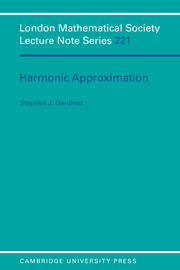Book contents
- Frontmatter
- Contents
- Preface
- 0 Review of thin sets
- 1 Approximation on compact sets
- 2 Fusion of harmonic functions
- 3 Approximation on relatively closed sets
- 4 Carleman approximation
- 5 Tangential approximation at infinity
- 6 Superharmonic extension and approximation
- 7 The Dirichlet problem with non-compact boundary
- 8 Further applications
- References
- Index
6 - Superharmonic extension and approximation
Published online by Cambridge University Press: 17 September 2009
- Frontmatter
- Contents
- Preface
- 0 Review of thin sets
- 1 Approximation on compact sets
- 2 Fusion of harmonic functions
- 3 Approximation on relatively closed sets
- 4 Carleman approximation
- 5 Tangential approximation at infinity
- 6 Superharmonic extension and approximation
- 7 The Dirichlet problem with non-compact boundary
- 8 Further applications
- References
- Index
Summary
Introduction
Many of the results in the preceding chapters have superharmonic analogues, some of which we will consider in this chapter. Thus, for example, we will examine which pairs (Ω, E) have the property that every u in S(E) can be uniformly approximated on E by functions in S(Ω). However, in the case of superharmonic functions, it may be possible not only to approximate, but even to extend, functions in S(E).
For example, suppose that K is a compact subset of an open set Ω such that Ω*\K is connected. Then, as we saw in Theorem 1.7, for every u in H(K) and every positive number ∈, there exists υ in H(Ω) such that |υ – u| < ∈ on K. The corresponding fact for superharmonic functions (a special case of Theorem 6.1 below) is that, for every u in S(K) there exists v in S(Ω) such that v = u on K.
Strong Extension
We begin the chapter with some such extension results. Later we will deal with Runge and Arakelyan approximation. Throughout this chapter Ω denotes an open set in Rn and E is a relatively closed subset of Ω. By a continuous superharmonic function we mean one which is both finite-valued and continuous.
We call (Ω, E) an extension pair for superharmonic functions (resp. for continuous superharmonic functions) if, for each function (resp. each continuous function) u in S(E) there exists υ in S(Ω) (resp. in C(Ω)∩S(Ω)) such that υ = u on E.
- Type
- Chapter
- Information
- Harmonic Approximation , pp. 85 - 102Publisher: Cambridge University PressPrint publication year: 1995



